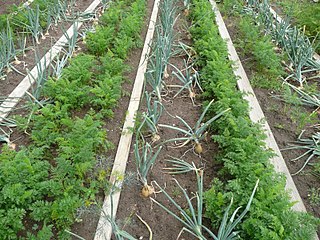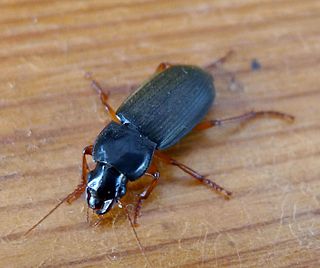
Companion planting in gardening and agriculture is the planting of different crops in proximity for any of a number of different reasons, including weed suppression, pest control, pollination, providing habitat for beneficial insects, maximizing use of space, and to otherwise increase crop productivity. Companion planting is a form of polyculture.

Biological control or biocontrol is a method of controlling pests, whether pest animals such as insects and mites, weeds, or pathogens affecting animals or plants by using other organisms. It relies on predation, parasitism, herbivory, or other natural mechanisms, but typically also involves an active human management role. It can be an important component of integrated pest management (IPM) programs.

Aphids are small sap-sucking insects and members of the superfamily Aphidoidea. Common names include greenfly and blackfly, although individuals within a species can vary widely in color. The group includes the fluffy white woolly aphids. A typical life cycle involves flightless females giving live birth to female nymphs—who may also be already pregnant, an adaptation scientists call telescoping generations—without the involvement of males. Maturing rapidly, females breed profusely so that the number of these insects multiplies quickly. Winged females may develop later in the season, allowing the insects to colonize new plants. In temperate regions, a phase of sexual reproduction occurs in the autumn, with the insects often overwintering as eggs.

Hemiptera is an order of insects, commonly called true bugs, comprising over 80,000 species within groups such as the cicadas, aphids, planthoppers, leafhoppers, assassin bugs, bed bugs, and shield bugs. They range in size from 1 mm (0.04 in) to around 15 cm (6 in), and share a common arrangement of piercing-sucking mouthparts. The name "true bugs" is often limited to the suborder Heteroptera.

Parasitoid wasps are a large group of hymenopteran superfamilies, with all but the wood wasps (Orussoidea) being in the wasp-waisted Apocrita. As parasitoids, they lay their eggs on or in the bodies of other arthropods, sooner or later causing the death of these hosts. Different species specialise in hosts from different insect orders, most often Lepidoptera, though some select beetles, flies, or bugs; the spider wasps (Pompilidae) exclusively attack spiders.

Myrmecophily consists of positive, mutualistic, interspecies associations between ants and a variety of other organisms, such as plants, other arthropods, and fungi. It may also include commensal or even parasitic interactions.

Aphidoletes aphidimyza, commonly referred to as the aphid midge, is a midge whose larvae feed on over 80 aphid species, including the green peach aphid.

Melampyrum pratense, the common cow-wheat, is a plant species in the family Orobanchaceae.

Oligolophus is a genus of the harvestman family Phalangiidae with four described species.

Coccinellidae is a widespread family of small beetles. They are commonly known as ladybugs in North America and ladybirds in the United Kingdom; "lady" refers to the Virgin Mary. Entomologists use the names ladybird beetles or lady beetles to avoid confusion with true bugs. The more than 6,000 described species have a global distribution and are found in a variety of habitats. They are oval beetles with a domed back and flat underside. Many of the species have conspicuous aposematic (warning) colours and patterns, such as red with black spots, that warn potential predators that they taste bad.

Helice tridens is a species of crab which lives on mudflats around the coasts of Japan and the Korean Peninsula.

The soybean aphid is an insect pest of soybean that is exotic to North America. The soybean aphid is native to Asia. It has been described as a common pest of soybeans in China and as an occasional pest of soybeans in Indonesia, Japan, Korea, Malaysia, the Philippines, and Thailand. The soybean aphid was first documented in North America in Wisconsin in July 2000. Ragsdale et al. (2004) noted that the soybean aphid probably arrived in North America earlier than 2000, but remained undetected for a period of time. Venette and Ragsdale (2004) suggested that Japan probably served as the point of origin for the soybean aphid's North American invasion. By 2003, the soybean aphid had been documented in Delaware, Georgia, Illinois, Indiana, Iowa, Kansas, Kentucky, Michigan, Minnesota, Mississippi, Missouri, Nebraska, New York, North Dakota, Ohio, Pennsylvania, South Dakota, Virginia, West Virginia, and Wisconsin. Together, these states accounted for 89% of the 63,600,000 acres (257,000 km2) of soybean planted in the United States in 2007.

Myzus persicae, known as the green peach aphid, greenfly, or the peach-potato aphid, is a small green aphid belonging to the order Hemiptera. It is the most significant aphid pest of peach trees, causing decreased growth, shrivelling of the leaves and the death of various tissues. It also acts as a vector for the transport of plant viruses such as cucumber mosaic virus (CMV), potato virus Y (PVY) and tobacco etch virus (TEV). Potato virus Y and potato leafroll virus can be passed to members of the nightshade/potato family (Solanaceae), and various mosaic viruses to many other food crops.

The black bean aphid is a small black insect in the genus Aphis, with a broad, soft body, a member of the order Hemiptera. Other common names include blackfly, bean aphid, and beet leaf aphid. In the warmer months of the year, it is found in large numbers on the undersides of leaves and on the growing tips of host plants, including various agricultural crops and many wild and ornamental plants. Both winged and wingless forms exist, and at this time of year, they are all females. They suck sap from stems and leaves and cause distortion of the shoots, stunted plants, reduced yield, and spoiled crops. This aphid also acts as a vector for viruses that cause plant disease, and the honeydew it secretes may encourage the growth of sooty mould. It breeds profusely by live birth, but its numbers are kept in check, especially in the later part of the summer, by various predatory and parasitic insects. Ants feed on the honeydew it produces, and take active steps to remove predators. It is a widely distributed pest of agricultural crops and can be controlled by chemical or biological means. In the autumn, winged forms move to different host plants, where both males and females are produced. These mate and the females lay eggs which overwinter.

Cycloneda sanguinea, also known as the spotless lady beetle, is a widespread species of ladybird beetle in the Americas.

Chemical defense is a strategy employed by many organisms to avoid consumption by producing toxic or repellent metabolites or chemical warnings which incite defensive behavioral changes. The production of defensive chemicals occurs in plants, fungi, and bacteria, as well as invertebrate and vertebrate animals. The class of chemicals produced by organisms that are considered defensive may be considered in a strict sense to only apply to those aiding an organism in escaping herbivory or predation. However, the distinction between types of chemical interaction is subjective and defensive chemicals may also be considered to protect against reduced fitness by pests, parasites, and competitors. Repellent rather than toxic metabolites are allomones, a sub category signaling metabolites known as semiochemicals. Many chemicals used for defensive purposes are secondary metabolites derived from primary metabolites which serve a physiological purpose in the organism. Secondary metabolites produced by plants are consumed and sequestered by a variety of arthropods and, in turn, toxins found in some amphibians, snakes, and even birds can be traced back to arthropod prey. There are a variety of special cases for considering mammalian antipredatory adaptations as chemical defenses as well.

Pemphigus spyrothecae, or the poplar spiral gall aphid, is a social insect which exhibits apparent altruistic behaviors. The aphids form galls and act as colony defenders, at times sacrificing their own lives to do so. It has been shown that colony defense is more likely in habitats that are difficult to obtain and can hold a large number of individuals. These gall locations are crucial because plants have a short window in which a gall can be produced. Thus, it is important for there to be a defense system that enables the aphids to retain their galls. The need for defense arises when the gall is opened up to allow winged aphid migrants to leave and to release any waste. The process of repairing the holes can take up to 10 days; during this time, the gall is susceptible to intruding predators.

Harpalus rufipes, commonly known as the strawberry seed beetle, is a species of ground beetle in the subfamily Harpalinae. It was described by Degeer in 1774, with the epithet rufipes being derived from Latin for red-footed. Harpalus rufipes is native to Europe. As a predator, Harpalus rufipes is used as a biological agent to control seed-eating pests including aphids and slugs such as Deroceras reticulatum, though they are known to feed on the seeds of strawberries. It has been used as a model organism to investigate the immune system of beetles, and a study has shown it is sensitive to engine oil and diesel oil.

Tritrophic interactions in plant defense against herbivory describe the ecological impacts of three trophic levels on each other: the plant, the herbivore, and its natural enemies. They may also be called multitrophic interactions when further trophic levels, such as soil microbes, endophytes, or hyperparasitoids are considered. Tritrophic interactions join pollination and seed dispersal as vital biological functions which plants perform via cooperation with animals.

Aphis spiraecola is a species of aphid described in 1914 by Edith Marion Patch. Its common names include green citrus aphid, Spirea aphid, and apple aphid. It is distributed worldwide, and is most abundant in the United States. It has a diploid chromosome number of 2n=8.




















